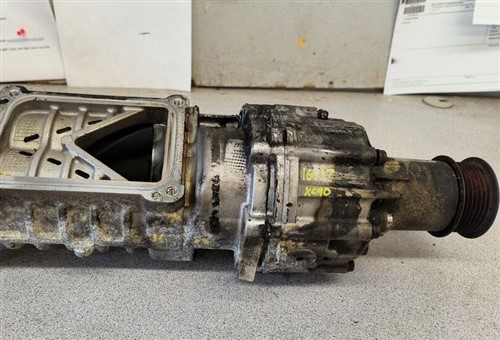
Image source: https://i.ebayimg.com/images/g/3OUAAOSwJOdlhI3h/s-l960.jpg
In Part 1 of this two-part article, we discussed the general operating principles of the superchargers used on Volvo T6 engines. Now, in part 2, we will look at these superchargers from a diagnostic perspective in terms of what to look out for when you are presented with a Volvo vehicle fitted with a T6 engine with a suspect supercharger. Let us start with this question-
Before we get to the specifics of this question, it is important to mention that several conditions can mimic the effects or symptoms of a failed supercharger. The usual suspects are clogged or damaged fuel injectors, marginally defective oxygen sensors that do not set trouble codes, or engine vacuum leaks that do not involve the supercharger, with leaking intake manifold gaskets or seals or defective vacuum check valves in the PCV box (aka oil trap) that is bolted to the top of the engine, being prime examples.
With the possible exception of clogged fuel injectors, all of the above issues can set code P0171 or other air/fuel metering codes via different paths. Therefore, this writer recommends that you do not jump to diagnostic conclusions and condemn the supercharger out of hand when you encounter lean running or LTFT (Long Term Fuel Trim) codes on Volvo T6 engines. For reasons that we will explain later, dealing with the proverbial low-hanging fruit (the easiest faults to fix) first is always a sound strategy when dealing with late-model Volvo vehicles.
Having said the above, it is also important to note that most actual supercharger failures on a T6 engine will usually, but not always, set code P0171 – "Fuel System Too Lean" before such failures will set any other trouble codes. The reason for this is that the most common supercharger failures allow unmetered to enter the engine, which directly affects fuel trim values because the ECU will add fuel to compensate for the additional oxygen in the exhaust stream.
Consider the list below of parts of a T6 supercharger that could potentially allow unmetered air to enter the engine; note that OEM part numbers are included for reference purposes-
|
Part Number |
Part Name |
|
32222165 |
Resonator |
|
32222167 |
Fresh air intake |
|
32252302 |
Sound insulation |
|
31492821 |
Sound insulation |
|
31657599 |
Bellows |
|
31459808 |
Gasket |
|
31459809 |
Bracket |
|
31657725 |
Plug |
|
31657726 |
O-Ring |
|
314744343 |
Sealing Ring |
|
32222126 |
O-Ring |
|
982758 |
Flange Supercharger 1 |
|
30622986 |
Flange Supercharger 2 |
While not all the items on this list may always be defective, worn, or damaged, it is rarely possible to repair a supercharger successfully by only replacing the parts that are obviously damaged or defective in some way. In practice, some parts (on this list) must be removed from the supercharger assembly to fit some replacement parts and since especially rubber seals may have hardened during their long use, it is almost inevitable that these parts will crack or break when they are disturbed in any way. Therefore, this writer recommends that all the parts on the list above be replaced to ensure a professional and lasting repair of the supercharger.
In addition, it is always a good idea also to replace the upstream oxygen sensor while the supercharger is removed from the engine because getting to the oxygen sensor with the supercharger in place is very difficult.
So, at the risk of overstating the case, superchargers on T6 engines typically do not fail because they contain parts that are inherently bad, poorly designed, or not fit for their tasks. In the vast majority of cases, these superchargers fail simply because one or more internal parts have become worn out as a result of long use, which raises the question of-
Well, you can't tell really or at least not initially, before removing the supercharger and dismantling it for closer inspection of its internal parts. However, if you are presented with a T6-engined Volvo, and you find trouble code P0171 or other air/fuel metering codes, abnormal fuel trim values, or catalytic converter efficiency codes there is a kind of procedure you can follow to reduce the chances of making a misdiagnosis. Here are the basic steps to follow, but before we continue, it might be helpful to look briefly into-
Although many modern high-end generic scan tools can extract generic fault codes from modern Volvo vehicles, that is about all they can do- provide basic trouble codes and their definitions. For instance, if you find trouble code P0171 with a generic scan tool, all that the scan tool will display is the code’s definition, i.e., “Fuel System Too Lean”.
What you need to diagnose modern Volvo vehicles is a software suite called “VIDA”, which stands for “Vehicle Information and Diagnostics for After Sales”. If VIDA runs on a suitable laptop computer, it is the only software that will give you things like-
In this context, freeze frame data is extremely important because it will tell you things like what the boost pressure was when the supercharger fault occurred. VIDA will also give you accurate information on fuel trim values when the failure occurred, so if you add abnormal fuel trim values to poor boost pressure, you almost always arrive at a failed supercharger.
Although VIDA is available as a rather expensive subscription, it is more cost-effective to obtain supercharger repair information from a Volvo dealer via the mandatory data sharing law/scheme. VIDA is also the only software that will allow you to reprogram Volvo control modules, but note that VIDA 2014D only supports Volvo vehicles up to the 2015 production year. Later models require an updated and reworked edition of VIDA, so be sure to know what model-year vehicle you are dealing with, which brings us back to the topic of diagnosing T6 superchargers-

It is crucially important to obtain as much information as possible about the customer’s concerns from the customer directly. Things you will want to know include the following-
The object of this exercise is to establish the most likely cause of the increased fuel consumption and excessive smoke from the exhaust, both of which are prime indicators of possible supercharger failures on T6 engines. We listed some common causes of air/fuel metering codes in Part 1 of this article, and all of these potential causes must be considered alongside the customer’s responses to the above questions as a first step in diagnosing any issues that involve the supercharger.
NOTE: It is worth mentioning that even relatively small vacuum leaks in the intake system can have disproportionate effects on the overall efficiency of the forced induction systems on T6 engines. Moreover, small intake vacuum leaks can mimic the effects of some actual supercharger failures, and so if you do not have freeze frame data, you can easily fall into a diagnostic rabbit hole, which leaves us with-
In a follow-up article, we will continue this discussion on diagnosing supercharger failures on Volvo T6 engines by explaining the most common and most effective method of confirming or eliminating supercharger failures on Volvo T6 engines. However, while this method is quick, reliable, and easy to do, this method can also yield inaccurate, misleading, or inconclusive results if it is not performed with some forethought and planning.